+ データを開く
データを開く
- 基本情報
基本情報
| 登録情報 | データベース: PDB / ID: 8vcv | |||||||||||||||||||||||||||||||||||||||||||||
|---|---|---|---|---|---|---|---|---|---|---|---|---|---|---|---|---|---|---|---|---|---|---|---|---|---|---|---|---|---|---|---|---|---|---|---|---|---|---|---|---|---|---|---|---|---|---|
| タイトル | Lineage IV Lassa virus glycoprotein (Josiah) in complex with rabbit polyclonal antibody (GPC-C epitope) | |||||||||||||||||||||||||||||||||||||||||||||
 要素 要素 |
| |||||||||||||||||||||||||||||||||||||||||||||
 キーワード キーワード | VIRAL PROTEIN/IMMUNE SYSTEM / Lassa / polyclonal antibody / GPC-C / glycoprotein / VIRAL PROTEIN / VIRAL PROTEIN-IMMUNE SYSTEM complex | |||||||||||||||||||||||||||||||||||||||||||||
| 機能・相同性 |  機能・相同性情報 機能・相同性情報host cell Golgi membrane / receptor-mediated endocytosis of virus by host cell / host cell endoplasmic reticulum membrane / fusion of virus membrane with host endosome membrane / viral envelope / virion attachment to host cell / host cell plasma membrane / virion membrane / metal ion binding / membrane 類似検索 - 分子機能 | |||||||||||||||||||||||||||||||||||||||||||||
| 生物種 |  Lassa virus Josiah (ウイルス) Lassa virus Josiah (ウイルス) | |||||||||||||||||||||||||||||||||||||||||||||
| 手法 | 電子顕微鏡法 / 単粒子再構成法 / クライオ電子顕微鏡法 / 解像度: 2.8 Å | |||||||||||||||||||||||||||||||||||||||||||||
 データ登録者 データ登録者 | Brouwer, P.J.M. / Perrett, H.R. / Ward, A.B. | |||||||||||||||||||||||||||||||||||||||||||||
| 資金援助 |  米国, 1件 米国, 1件
| |||||||||||||||||||||||||||||||||||||||||||||
 引用 引用 |  ジャーナル: Cell Rep / 年: 2024 ジャーナル: Cell Rep / 年: 2024タイトル: Defining bottlenecks and opportunities for Lassa virus neutralization by structural profiling of vaccine-induced polyclonal antibody responses. 著者: Philip J M Brouwer / Hailee R Perrett / Tim Beaumont / Haye Nijhuis / Sabine Kruijer / Judith A Burger / Ilja Bontjer / Wen-Hsin Lee / James A Ferguson / Martin Schauflinger / Helena Müller- ...著者: Philip J M Brouwer / Hailee R Perrett / Tim Beaumont / Haye Nijhuis / Sabine Kruijer / Judith A Burger / Ilja Bontjer / Wen-Hsin Lee / James A Ferguson / Martin Schauflinger / Helena Müller-Kräuter / Rogier W Sanders / Thomas Strecker / Marit J van Gils / Andrew B Ward /    要旨: Lassa fever continues to be a major public health burden in West Africa, yet effective therapies or vaccines are lacking. The isolation of protective neutralizing antibodies against the Lassa virus ...Lassa fever continues to be a major public health burden in West Africa, yet effective therapies or vaccines are lacking. The isolation of protective neutralizing antibodies against the Lassa virus glycoprotein complex (GPC) justifies the development of vaccines that can elicit strong neutralizing antibody responses. However, Lassa vaccine candidates have generally been unsuccessful at doing so, and the associated antibody responses to these vaccines remain poorly characterized. Here, we establish an electron microscopy-based epitope mapping workflow that enables high-resolution structural characterization of polyclonal antibodies to the GPC. By applying this method to rabbits vaccinated with a recombinant GPC vaccine and a GPC-derived virus-like particle, we reveal determinants of neutralization that involve epitopes of the GPC-A competition cluster. Furthermore, by identifying undescribed immunogenic off-target epitopes, we expose the challenges that recombinant GPC vaccines face. By enabling detailed polyclonal antibody characterization, our work ushers in a next generation of more rational Lassa vaccine design. | |||||||||||||||||||||||||||||||||||||||||||||
| 履歴 |
|
- 構造の表示
構造の表示
| 構造ビューア | 分子:  Molmil Molmil Jmol/JSmol Jmol/JSmol |
|---|
- ダウンロードとリンク
ダウンロードとリンク
- ダウンロード
ダウンロード
| PDBx/mmCIF形式 |  8vcv.cif.gz 8vcv.cif.gz | 284.1 KB | 表示 |  PDBx/mmCIF形式 PDBx/mmCIF形式 |
|---|---|---|---|---|
| PDB形式 |  pdb8vcv.ent.gz pdb8vcv.ent.gz | 222.7 KB | 表示 |  PDB形式 PDB形式 |
| PDBx/mmJSON形式 |  8vcv.json.gz 8vcv.json.gz | ツリー表示 |  PDBx/mmJSON形式 PDBx/mmJSON形式 | |
| その他 |  その他のダウンロード その他のダウンロード |
-検証レポート
| 文書・要旨 |  8vcv_validation.pdf.gz 8vcv_validation.pdf.gz | 3.1 MB | 表示 |  wwPDB検証レポート wwPDB検証レポート |
|---|---|---|---|---|
| 文書・詳細版 |  8vcv_full_validation.pdf.gz 8vcv_full_validation.pdf.gz | 3.1 MB | 表示 | |
| XML形式データ |  8vcv_validation.xml.gz 8vcv_validation.xml.gz | 57.9 KB | 表示 | |
| CIF形式データ |  8vcv_validation.cif.gz 8vcv_validation.cif.gz | 85 KB | 表示 | |
| アーカイブディレクトリ |  https://data.pdbj.org/pub/pdb/validation_reports/vc/8vcv https://data.pdbj.org/pub/pdb/validation_reports/vc/8vcv ftp://data.pdbj.org/pub/pdb/validation_reports/vc/8vcv ftp://data.pdbj.org/pub/pdb/validation_reports/vc/8vcv | HTTPS FTP |
-関連構造データ
| 関連構造データ |  43141MC  8tycC  8tyeC 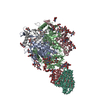 8ve8C 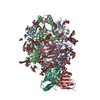 9cj7C 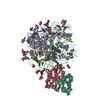 9cj8C 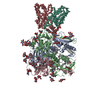 9ck7C  9ck8C M: このデータのモデリングに利用したマップデータ C: 同じ文献を引用 ( |
|---|---|
| 類似構造データ | 類似検索 - 機能・相同性  F&H 検索 F&H 検索 |
- リンク
リンク
- 集合体
集合体
| 登録構造単位 | 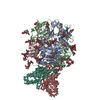
|
|---|---|
| 1 |
|
- 要素
要素
-Glycoprotein ... , 2種, 6分子 ABCabc
| #1: タンパク質 | 分子量: 29010.352 Da / 分子数: 3 / 由来タイプ: 組換発現 / 由来: (組換発現)  Lassa virus Josiah (ウイルス) / 遺伝子: GPC / 細胞株 (発現宿主): HEK293F / 発現宿主: Lassa virus Josiah (ウイルス) / 遺伝子: GPC / 細胞株 (発現宿主): HEK293F / 発現宿主:  Homo sapiens (ヒト) / 参照: UniProt: P08669 Homo sapiens (ヒト) / 参照: UniProt: P08669#4: タンパク質 | 分子量: 44765.047 Da / 分子数: 3 / 由来タイプ: 組換発現 / 由来: (組換発現)  Lassa virus Josiah (ウイルス) / 遺伝子: GPC, GP-C / 細胞株 (発現宿主): HEK293F / 発現宿主: Lassa virus Josiah (ウイルス) / 遺伝子: GPC, GP-C / 細胞株 (発現宿主): HEK293F / 発現宿主:  Homo sapiens (ヒト) / 参照: UniProt: P08669 Homo sapiens (ヒト) / 参照: UniProt: P08669 |
|---|
-抗体 , 2種, 2分子 HL
| #2: 抗体 | 分子量: 10656.127 Da / 分子数: 1 / 由来タイプ: 天然 / 由来: (天然)  |
|---|---|
| #3: 抗体 | 分子量: 9379.553 Da / 分子数: 1 / 由来タイプ: 天然 / 由来: (天然)  |
-糖 , 8種, 33分子 
| #5: 多糖 | beta-D-mannopyranose-(1-4)-2-acetamido-2-deoxy-beta-D-glucopyranose-(1-4)-[alpha-L-fucopyranose-(1- ...beta-D-mannopyranose-(1-4)-2-acetamido-2-deoxy-beta-D-glucopyranose-(1-4)-[alpha-L-fucopyranose-(1-6)]2-acetamido-2-deoxy-beta-D-glucopyranose | ||||||||||||
|---|---|---|---|---|---|---|---|---|---|---|---|---|---|
| #6: 多糖 | 2-acetamido-2-deoxy-beta-D-glucopyranose-(1-4)-2-acetamido-2-deoxy-beta-D-glucopyranose #7: 多糖 | beta-D-mannopyranose-(1-4)-2-acetamido-2-deoxy-beta-D-glucopyranose-(1-4)-2-acetamido-2-deoxy-beta- ...beta-D-mannopyranose-(1-4)-2-acetamido-2-deoxy-beta-D-glucopyranose-(1-4)-2-acetamido-2-deoxy-beta-D-glucopyranose #8: 多糖 | 2-acetamido-2-deoxy-beta-D-glucopyranose-(1-4)-[alpha-L-fucopyranose-(1-6)]2-acetamido-2-deoxy-beta- ...2-acetamido-2-deoxy-beta-D-glucopyranose-(1-4)-[alpha-L-fucopyranose-(1-6)]2-acetamido-2-deoxy-beta-D-glucopyranose #9: 多糖 | alpha-D-mannopyranose-(1-2)-alpha-D-mannopyranose-(1-3)-beta-D-mannopyranose-(1-4)-2-acetamido-2- ...alpha-D-mannopyranose-(1-2)-alpha-D-mannopyranose-(1-3)-beta-D-mannopyranose-(1-4)-2-acetamido-2-deoxy-beta-D-glucopyranose-(1-4)-2-acetamido-2-deoxy-beta-D-glucopyranose | #10: 多糖 | alpha-D-mannopyranose-(1-2)-alpha-D-mannopyranose-(1-3)-[alpha-D-mannopyranose-(1-6)]beta-D- ...alpha-D-mannopyranose-(1-2)-alpha-D-mannopyranose-(1-3)-[alpha-D-mannopyranose-(1-6)]beta-D-mannopyranose-(1-4)-2-acetamido-2-deoxy-beta-D-glucopyranose-(1-4)-2-acetamido-2-deoxy-beta-D-glucopyranose | #11: 多糖 | alpha-D-mannopyranose-(1-3)-beta-D-mannopyranose-(1-4)-2-acetamido-2-deoxy-beta-D-glucopyranose-(1- ...alpha-D-mannopyranose-(1-3)-beta-D-mannopyranose-(1-4)-2-acetamido-2-deoxy-beta-D-glucopyranose-(1-4)-2-acetamido-2-deoxy-beta-D-glucopyranose | #12: 糖 | ChemComp-NAG / |
-詳細
| 研究の焦点であるリガンドがあるか | N |
|---|---|
| Has protein modification | Y |
-実験情報
-実験
| 実験 | 手法: 電子顕微鏡法 |
|---|---|
| EM実験 | 試料の集合状態: PARTICLE / 3次元再構成法: 単粒子再構成法 |
- 試料調製
試料調製
| 構成要素 | 名称: Lineage IV Lassa virus glycoprotein (Josiah) in complex with rabbit polyclonal antibody (GPC-C epitope) タイプ: COMPLEX / Entity ID: #1-#4 / 由来: NATURAL |
|---|---|
| 分子量 | 実験値: NO |
| 由来(天然) | 生物種:  |
| 緩衝液 | pH: 7.4 |
| 試料 | 濃度: 0.1 mg/ml / 包埋: NO / シャドウイング: NO / 染色: NO / 凍結: YES |
| 試料支持 | グリッドの材料: GRAPHENE OXIDE / グリッドのサイズ: 400 divisions/in. / グリッドのタイプ: Quantifoil R1.2/1.3 |
| 急速凍結 | 装置: FEI VITROBOT MARK IV / 凍結剤: ETHANE / 湿度: 100 % / 凍結前の試料温度: 277 K |
- 電子顕微鏡撮影
電子顕微鏡撮影
| 顕微鏡 | モデル: TFS GLACIOS |
|---|---|
| 電子銃 | 電子線源:  FIELD EMISSION GUN / 加速電圧: 200 kV / 照射モード: FLOOD BEAM FIELD EMISSION GUN / 加速電圧: 200 kV / 照射モード: FLOOD BEAM |
| 電子レンズ | モード: BRIGHT FIELD / 最大 デフォーカス(公称値): 2000 nm / 最小 デフォーカス(公称値): 800 nm / アライメント法: COMA FREE |
| 試料ホルダ | 凍結剤: NITROGEN 試料ホルダーモデル: FEI TITAN KRIOS AUTOGRID HOLDER |
| 撮影 | 電子線照射量: 40.7 e/Å2 フィルム・検出器のモデル: TFS FALCON 4i (4k x 4k) |
- 解析
解析
| EMソフトウェア |
| |||||||||||||||||||||||||
|---|---|---|---|---|---|---|---|---|---|---|---|---|---|---|---|---|---|---|---|---|---|---|---|---|---|---|
| CTF補正 | タイプ: PHASE FLIPPING AND AMPLITUDE CORRECTION | |||||||||||||||||||||||||
| 対称性 | 点対称性: C1 (非対称) | |||||||||||||||||||||||||
| 3次元再構成 | 解像度: 2.8 Å / 解像度の算出法: FSC 0.143 CUT-OFF / 粒子像の数: 89195 / 対称性のタイプ: POINT | |||||||||||||||||||||||||
| 拘束条件 |
|
 ムービー
ムービー コントローラー
コントローラー






















 PDBj
PDBj


